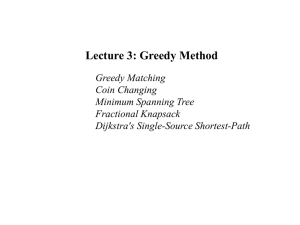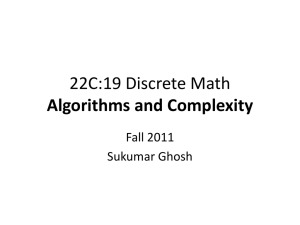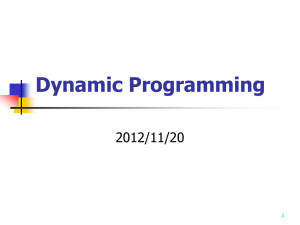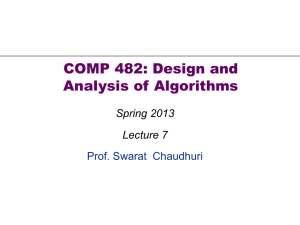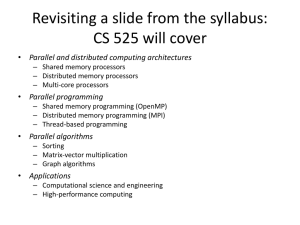Greedy algorithms
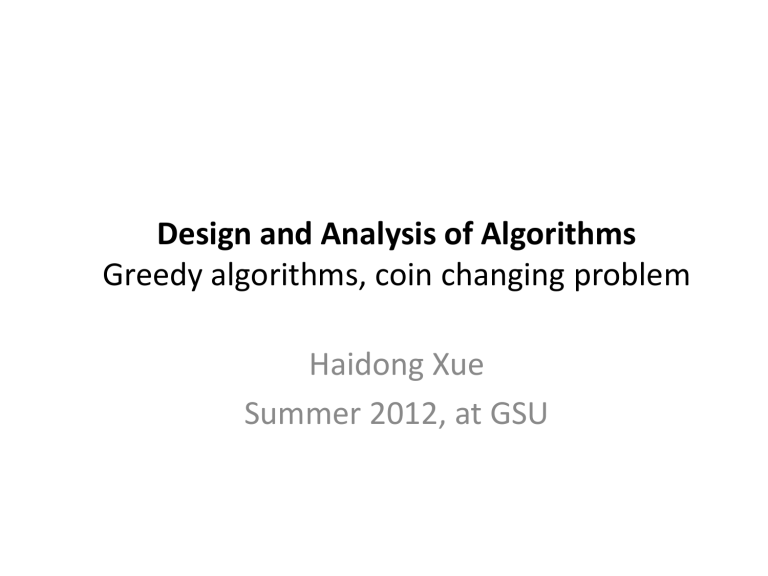
Design and Analysis of Algorithms
Greedy algorithms, coin changing problem
Haidong Xue
Summer 2012, at GSU
What is a greedy algorithm?
• Greedy algorithm: “an algorithm always makes the choice that looks best at the moment”
• Human beings use greedy algorithms a lot
– How to maximize your final grade of this class?
– How to become a rich man?
– How does a casher minimize the number of coins to make a change?
What is a greedy algorithm?
• How to maximize your final grade of this class?
MaximizeFinalGrade( quizzes and tests ){ if(no quiz and no test) return;
MaximizeFinalGrade (quizzes and tests – current one);
}
– This algorithm works very well for students
• Why is it correct?
What is a greedy algorithm?
Assuming that your performance of each quiz and test are independent
What if you did your best in the current quiz?
– You have the chance to get your maximum final grade
– The greedy choice is always part of certain optimal solution
What if you did not maximize the grades of the rest of the quizzes and tests?
– You get a lower final grade
– The optimal solution has to contain optimal solutions to subproblems
What is a greedy algorithm?
• To guarantee that a greedy algorithm is correct 2 things have to be proved:
– Greedy-choice property: “we can assemble a globally optimal solution by making locally greedy(optimal) choices.”
• i.e. The greedy choice is always part of certain optimal solution
– Optimal substructure: “an optimal solution to the problem contains within it optimal solutions to subproblems.”
• i.e. global optimal solution is constructed from local optimal solutions
What is a greedy algorithm?
• How to become a rich man?
• Problem: maximize the money I have on
8/1/2012 12:00PM
• A greedy algorithm:
}
Rich(certain time period P){
Collect as much money as I can in the current 3 hours;
//Greedy choice
Rich(P-3 hours);
What is a greedy algorithm?
• if Rich is implemented by Haydon
• Rich (between now and 8/1/2012 12pm )
• What are the choices I have in the most recent
3 hours?
– Finish this lecture like all the other instructors
• Money collected: 0
– Go to underground, be a beggar, repeatedly say
“hey generous man, gimme a quarter! ”
• Money collected: 2.5 (since k*0.25, k<=10)
What is a greedy algorithm?
• What are the choices I have in the most recent
3 hours?
– Rob BOA
• Money collected: 0 (got killed by cops)
– Rob my students
• Money collected: about 300
What is a greedy algorithm?
• Which one is the greedy choice?
– Teach algorithms
• Money collected: $0
– Be a beggar
• Money collected: $2.5 (since k*0.25, k<=10)
– Rob BOA
• Money collected: $0 (got killed by cops)
– Rob my students
//The greedy choice
• Money collected: about $300
What is a greedy algorithm?
• What happened if I robbed you?
– Students
• Report the criminal immediately
• Or report it after your final
– The instructor
• Cops confiscate the illicit $300, i.e. -300
• Get fired, and lose the stipend of this month, i.e. about -1400
• After making this greedy choice, what is the result of Rich
What is a greedy algorithm?
Rich (between now and 8/1/2012 12pm )
Collect as much money as I can in the current 3 hours;
Rich (between 1pm today and 8/1/2012 12pm );
}
Fail to achieve the optimal
• Greedy choice: $300 solution!
• However there is a influence on the optimal solution to the subproblem, which prevents the instructor from arriving the richest solution :
• the best of Rich (between 1pm today and 8/1/2012 12pm ) will be around -$1700
What is a greedy algorithm?
• Why the greedy Rich algorithm does not work?
– After robbing you, I have no chance to be to get the richest solution
– i.e. the greedy choice property is violated
What is a greedy algorithm?
+1400
• How to become a rich man?
In this problem, we do not have
– Teach algorithms greedy property
• Money collected: $0 So, greedy choice does not help
Got fired
– Be a beggar
2.5 -1400
And it is very consistent with what you see now
• Money collected: $2.5 (since k*0.25, k<=10)
Got killed
– Rob BOA
-infinity
• Money collected: $0 (got killed by cops)
– Rob my students
• Money collected: about $300
Coin changing problem
• An example:
– A hot dog and a drink at Costco are $1.50
– Plus tax it is: 1.5*1.08 = $1.62
– Often, we give the cashier 2 $1 notes
– She need to give back, 38 cents as change
• Generally, you never see she gives you 38 pennies.
• What is algorithm here?
Coin changing problem
• Coin changing problem (informal):
– Given certain amount of change: n cents
– The denominations of coins are: 25, 10, 5, 1
– How to use the fewest coins to make this change?
• i.e. n = 25a + 10b + 5c + d, what are the a, b, c, and d, minimizing (a+b+c+d)
• Can you design an algorithm to solve this problem?
Coin changing problem
• n = 25a + 10b + 5c + d, what are the a, b, c, and d, minimizing (a+b+c+d)
• How to do it in brute-force?
– At most we use n pennies
– Try all the combinations where a<=n, b<=n, c<=n, d<=n
– Choose all the combinations that n = 25a + 10b +
5c + d
– Choose the combination with smallest (a+b+c+d)
How many combinations?
Time complexity is Θ(𝑛 4 )
Θ(𝑛 4 )
Coin changing problem
• n = 25a + 10b + 5c + d, what are the a, b, c, and d, minimizing (a+b+c+d)
• How to do it in divide-and-conquer?
coinD&C( n ){
1. if(n<5) return (a=0, b=0, c=0, d=n, n)
2. if(n==5) return (a=0, b=0, c=1, d=0, 1)
3. if(n==10) return (a=0, b=1, c=0, d=0, 1)
4. if(n==25) return (a=1, b=0, c=0, d=0, 1)
5. s= min( coinD&C 𝑛 − 25 , coinD&C 𝑛 − 10 , coinD&C 𝑛 − 5 , coinD&C (𝑛 −
1)) ;
6. Increase s.a or s.b or s.c or s.d by 1 according to the coin used in the minimum one
7. return (s.a, s.b, s.c, s.sum+1);
What is the recurrence equation?
𝑇 𝑛 = 𝑇 𝑛 − 25 + 𝑇 𝑛 − 10 + 𝑇 𝑛 − 5 + 𝑇 𝑛 − 1 + 1
Time complexity?
𝑇 𝑛 ≤ 4𝑇(𝑛 − 1) and 𝑇 𝑛 ≥ 4𝑇(𝑛 − 25) , 𝑇 𝑛 = 𝑂 4 𝑛
= Ω(4 𝑛/25
)
Coin changing problem
• n = 25a + 10b + 5c + d, what are the a, b, c, and d, minimizing (a+b+c+d)
• How to do it in dynamic programming?
coinDP( n ){
1.
If(solution for n in memo) return memo(n);
2. if(n<5) return (a=0, b=0, c=0, d=n, n)
3. if(n==5) return (a=0, b=0, c=1, d=0, 1)
4. if(n==10) return (a=0, b=1, c=0, d=1, 1)
5. if(n==25) return (a=1, b=0, c=0, d=1, 1)
6. s= min( coinDP 𝑛 − 25 , coinDP 𝑛 − 10 , coinDP 𝑛 − 5 , coinDP (𝑛 − 1)) ;
7. Increase s.a or s.b or s.c or s.d by 1 according to the coin used in the minimum one
8. Put (s.a, s.b, s.c, s.sum+1) in memo as memo(n);
9. return (s.a, s.b, s.c, s.sum+1);
How many sub problems?
n
If subproblems are solved, how much time to solve a problem?
Θ (1)
Time complexity?
𝑇 𝑛 = Θ (n)
Coin changing problem
• n = 25a + 10b + 5c + d, what are the a, b, c, and d, minimizing (a+b+c+d)
• How to do it by a greedy algorithm?
coinGreedy( n ){ if(n>=25) s = coinGreedy(n-25); s.a++; else if(n>=10) s = coinGreedy(n-10); s.b++; else if(n>=5) s = coinGreedy(n-5); s.c++; else s=(a=0, b=0, c=0, d=n, sum=n); s.sum++; return s;
Greedy choice
Always choose the possible largest coin
It that greedy algorithm correct?
Time complexity?
𝑇 𝑛 = Θ (n)
If n is large, in most of the subproblems it chooses quarter, so it is much faster than dynamic 𝑛 programming 𝑇 𝑛 ≈ 𝐶(
25
) and in DP 𝑇 𝑛 ≈ 𝐶𝑛
Coin changing problem
• Optimal substructure
– After the greedy choice, assuming the greedy choice is correct, can we get the optimal solution from sub optimal result?
• 38 cents
• Assuming we have to choose 25
• Is a quarter + optimal coin(38-25) the optimal solution of 38 cents?
• Greedy choice property
– If we do not choose the largest coin, is there a better solution?
Coin changing problem
• For coin denominations of 25, 10, 5, 1
– The greedy choice property is not violated
• For other coin denominations
– May violate it
– E.g. 10, 7, 1
– 15 cents
• How to prove the greedy choice property for denominations 25, 10, 5, 1?
– Optimal structure --- easy to prove
– Greedy choice property
Coin changing problem
• 1. Prove that with coin denominations of “5, 1”, it has the greedy choice property
• Proof:
Apply greedy choice: n = 5 + 5c + d
In a optimal solution if there is a nickel, the proof is done
If there is no nickel: n = d’=5 + d’’
Need to prove that: 1+d’’ <= d’ d’=5+d’’ > 1+d’’
• For “5, 1”, it has greedy choice property, greedy algorithm works
Coin changing problem
• 2. Prove that with coin denominations of “10, 5, 1”, it has the greedy choice property
• Proof:
Apply greedy choice: n = 10 + 10b + 5c + d
– In a optimal solution if there is a dime, the proof is done
– If there is no dime : n = 5c’ + d’
• Since 5c’ + d’>=10
• with the conclusion of the previous slide, c’>=2
• 5c’ + d’ = 10 + 5(c’-2) + d’ and c’+d’ > 1+c’-2+d’
• it cannot be a optimal solution
• For “10, 5, 1”, it has greedy choice property, greedy algorithm works
Coin changing problem
• 3. Prove that with coin denominations of “25, 10, 5, 1”, it has the greedy choice property
• Proof:
Apply greedy choice: n = 25 + 25a + 10b + 5c + d
– In a optimal solution if there is a quarter, the proof is done
– If there is no quarter : n = 10b’+5c’+d’
• Since 10b’+5c’+d’ >= 25
• if 25<=n<30, with the conclusion of previous slide, b’>=2, c’>=1
– 10b’+5c’+d’ = 25 + 10(b’-2) + 5(c’-1) + d’ and b’+c’+d’>1+b’-2+c’-1+d’
– it cannot be a optimal solution
• if n>=30, with the conclusion of previous slide, b’>=3
– 10b’+5c’+d’ = 25 + 10(b’-3) + 5(c’+1) + d’ and b’+c’+d’>1+b’-3+c’+1+d’
– it cannot be a optimal solution
For “25, 10, 5, 1”, it has greedy choice property, greedy algorithm works

